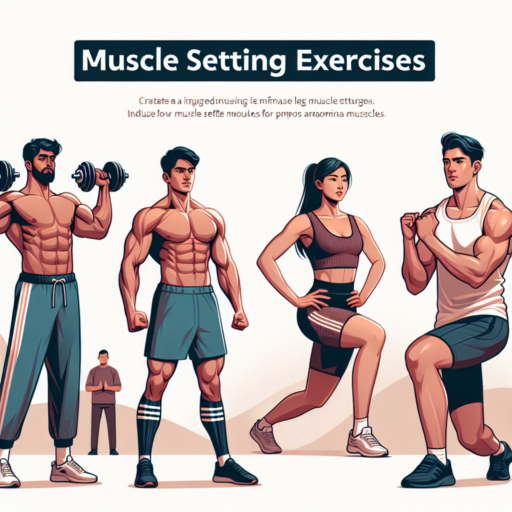Introduction to Muscle Setting Exercises
When we talk about Muscle Setting Exercises, we’re delving into a fundamental component of both physiotherapy and general fitness. These exercises are specially designed to stabilize and strengthen the muscles without necessarily increasing their size. Ideal for rehabilitation and prehabilitation, muscle setting exercises play a crucial role in a myriad of recovery processes.
At the heart of these exercises is the principle of muscle activation. Instead of focusing on lifting heavy weights or completing high-intensity workouts, the emphasis is on engaging and contracting the muscles in a controlled and deliberate manner. This method ensures that the muscle fibers are activated and strengthened, which is vital for both recovery and the building of a solid exercise foundation.
One of the key benefits of muscle setting exercises is their accessibility. Whether you’re a seasoned athlete or someone just starting their fitness journey, these exercises can be tailored to meet your specific needs and conditions. By focusing on the activation of muscles in a low-impact way, individuals can effectively enhance muscular endurance and stability without the risk of injury associated with more intensive workouts.
The Benefits of Incorporating Muscle Setting Exercises into Your Routine
Incorporating muscle setting exercises into your routine can offer a wide array of benefits that go beyond mere gains in muscle mass. These types of exercises, which involve tense and release techniques, are key for enhancing muscle tone and strength without the need for heavy weights. Participants can enjoy increased muscle control and stability, which are crucial for both everyday movements and advanced physical training.
Improved Muscle Strength: One of the primary advantages of muscle setting exercises is the significant improvement in overall muscle strength. This type of exercise targets specific muscle groups, allowing for a focused strengthening approach. The technique of tensing muscles without movement helps in recruiting a greater number of muscle fibers, thereby increasing muscle strength over time with regular practice.
Enhanced Stability and Decreased Injury Risk: Another noteworthy benefit is the role of muscle setting exercises in enhancing stability and balance. By focusing on control and precision during the tense and release phases, practitioners develop a deeper awareness of their body’s positioning and movement. This increased proprioception not only improves performance in various physical activities but also significantly reduces the risk of injuries by promoting more stable and controlled movements.
Top 5 Muscle Setting Exercises for Beginners
Embarking on a fitness journey can feel overwhelming at first. However, starting with the right exercises is crucial for building a solid foundation. Below, we lay out the top 5 muscle-setting exercises that are perfect for beginners. These exercises are designed to engage multiple muscle groups, promoting overall strength and stability.
1. Squats
Squats are a powerhouse move for leg and core strengthening. They target your quadriceps, hamstrings, glutes, lower back, and calves. Ensure proper form by keeping your feet shoulder-width apart and your back straight as you lower down as if sitting in a chair.
2. Push-ups
Push-ups are an excellent exercise for building upper body strength, focusing on your chest, shoulders, and triceps. Beginners can start with modified push-ups on their knees to build strength before progressing to full push-ups.
3. Planks
Planks are a fantastic core strengthening exercise. They work not only your abs but also your back and shoulders. Aim for holding a plank for 30 seconds to start, gradually increasing your time as you get stronger.
Starting with these primary exercises can help beginners set a robust muscle foundation, encouraging progression and preventing injury. Emphasizing form over quantity initially ensures a safer and more effective workout routine. As you become comfortable with these exercises, you’ll be ready to explore more challenging workouts, enhancing your strength and endurance further.
How to Intensify Your Muscle Setting Exercises for Advanced Results
When looking to elevate your fitness regime for advanced muscle-toning benefits, incorporating higher intensity into your muscle setting exercises is key. Here’s a brief guide on how to do just that, ensuring you push beyond your current limits responsibly.
Alter Your Exercise Tempo
Changing the speed of your movements during exercise can significantly affect the intensity of your workout. Experiment with slowing down the eccentric (lowering) phase of your lifts, holding for a moment at the peak contraction, and then steadily returning to the starting position. This method increases time under tension, a crucial factor for muscle growth.
Incorporate Advanced Techniques
To further advance your workout, consider integrating techniques such as drop sets, super sets, or pyramid sets. These methods challenge your muscles by altering the weight, reps, or quickly shifting from one exercise to another without rest. The sudden shift in demand on your muscles can lead to greater strength gains and endurance over time.
Understanding the Science Behind Muscle Setting and Its Impact on Your Body
Absolutely, focusing exclusively on the topic provided:
The concept of muscle setting, often entwined with the broader discussions on physical fitness and rehabilitation, involves the intricate process by which muscles adapt and transform in response to various stimuli. At the heart of this science is the understanding of how our muscles operate on a cellular level, especially in reaction to exercises and physical stressors. Muscle hypertrophy and neuromuscular adaptation are key components in this process, illuminating the path to how we can optimize our bodies for strength, endurance, and recovery.
Harnessing the power of muscle setting begins with the recognition of two primary mechanisms: muscle tension and muscle damage. Muscle tension refers to the stress experienced by muscle fibers during resistance training, compelling these fibers to adapt and grow stronger over time. On the other hand, muscle damage, often a result of novel or intense physical activity, triggers cellular repair responses, leading to muscle fiber fortification and, eventually, muscle hypertrophy. Understanding these foundational elements is crucial for effective training and injury prevention.
Furthermore, the endocrine response plays a pivotal role in muscle setting. During and after vigorous exercise, our bodies release several hormones, including growth hormone and testosterone, which significantly impact muscle growth and recovery. This hormonal surge facilitates the repair of muscle tissues and enhances the synthesis of proteins, essential for muscle hypertrophy. Recognizing the interplay between these physiological and biochemical processes underscores the complexity and efficiency of our bodily systems in adapting to physical challenges.
The Role of Nutrition in Maximizing the Effects of Muscle Setting Exercises
Nutrition plays a pivotal role in enhancing the effectiveness of muscle setting exercises. The synergy between proper dietary intake and physical training cannot be overstated. When the body receives the right nutrients, it can rebuild muscle fibers more efficiently, leading to better strength and muscle growth. Understanding the types of nutrients your body needs during muscle setting exercises is essential for achieving optimal results.
Proteins are the building blocks of muscle. Consuming an adequate amount of protein is crucial for muscle repair and growth. However, carbohydrates are equally important as they refill the body’s energy stores, allowing for more intense and prolonged workout sessions. Furthermore, healthy fats contribute to hormone regulation, which plays a significant role in muscle development. Integrating a balanced diet that includes all these macronutrients can significantly amplify the outcomes of muscle setting exercises.
Hydration is another critical aspect of maximizing exercise effects. Water facilitates the transportation of nutrients to the muscles, aiding in recovery and growth. Moreover, being well-hydrated improves workout performance by maintaining optimal body temperature and joint lubrication. Thus, coupling muscle setting exercises with proper nutrition and hydration strategies creates an ideal environment for muscle growth and strength enhancement.
A Step-by-Step Guide to Performing Muscle Setting Exercises Correctly
Muscle setting exercises are a fundamental component of any comprehensive fitness routine, aimed at enhancing muscle strength and endurance without excessive strain. These exercises, when performed correctly, can significantly contribute to your overall physical health and wellbeing. This guide will delve into the nuances of executing these exercises effectively, ensuring you reap maximum benefits.
Understanding Muscle Setting Exercises
Muscle setting exercises involve minimal movement, focusing instead on tensing the muscles and holding that tension for a set period. This method is particularly beneficial for beginners or individuals recovering from injury, as it helps activate and strengthen muscles safely. Key to these exercises is the awareness of one’s body and the ability to control muscle tension deliberately.
Steps to Perform Muscle Setting Exercises
- Choose the Right Environment: Find a comfortable, quiet space where you can focus without interruptions. A mat or soft surface can enhance comfort.
- Start with a Warm-Up: Begin with gentle stretches or a light aerobic activity to increase blood flow to your muscles, preparing them for exercise.
- Focus on Form: Proper form is crucial. Ensure your back is straight and you’re breathing calmly and steadily. Tighten your muscles slowly, hold the tension, then gradually relax.
- Hold and Release: Hold the muscle contraction for about 5 to 10 seconds, then release. Repeat this sequence several times, focusing on different muscle groups.
Integrating muscle setting exercises into your routine offers a safe and effective way to build muscular strength and endurance. With consistent practice and attention to form, these exercises can serve as a foundation for more dynamic strength training activities.
Common Mistakes to Avoid When Doing Muscle Setting Exercises
Muscle setting exercises, often a key component of rehabilitation and strength programs, can significantly improve muscle tone and joint stability when done correctly. However, certain common mistakes can undermine the effectiveness of these exercises and even lead to injuries. Recognizing and avoiding these errors is crucial for achieving the best results and ensuring a safe workout routine.
Neglecting Proper Form
One of the most prevalent mistakes in performing muscle setting exercises is neglecting proper form. Many individuals focus solely on completing a certain number of repetitions rather than on executing the movements with precision. This oversight can not only reduce the efficacy of the exercise but also increase the risk of straining muscles or joints. It’s essential to understand and maintain the correct posture and alignment throughout the exercise, engaging the right muscle groups and avoiding unnecessary stress on other parts of the body.
Overlooking Warm-Up and Cool-Down Phases
Another critical mistake is skipping the warm-up and cool-down phases of a workout. Beginning an exercise routine without adequately preparing the muscles can lead to stiffness and limit the range of motion, thereby diminishing the workout’s overall effectiveness. Similarly, neglecting the cool-down can cause muscles to tighten and become sore, hindering recovery. Incorporating a proper warm-up routine that gradually increases heart rate and blood flow, along with a cool-down period that includes stretching, can significantly enhance the muscle setting exercise outcomes.
Ignoring the Body’s Signals is a common pitfall that many fall into during their muscle setting exercise routines. It’s crucial to listen to your body and respond appropriately to any discomfort or pain. While some muscle fatigue is expected during these exercises, sharp or persistent pain may indicate that an exercise is being performed incorrectly or that a particular movement is not suitable for your current level of fitness. Adjusting the exercise to accommodate your body’s limitations and seeking professional advice when necessary can help prevent injuries and ensure a productive and safe workout regimen.
Incorporating Muscle Setting Exercises into Your Daily Routine
Integrating muscle setting exercises into your lifestyle can significantly enhance your physical fitness without requiring a massive time investment. These types of exercises, often overlooked, provide a variety of benefits, including improved muscle tone, strength, and stability. By focusing on precision and control, muscle setting exercises provide a foundation that supports other forms of physical activity, making them a valuable addition to any daily routine.
One of the key advantages of muscle setting exercises is their flexibility. Whether you have a fully-equipped gym at your disposal or are working with limited space and no equipment at home, these exercises can be easily adjusted to fit your environment. For instance, simple isometric exercises, which involve contracting a specific muscle or group of muscles, can be performed anywhere and have been shown to effectively increase muscle strength and endurance over time.
Examples of Muscle Setting Exercises
- Planks: Engages multiple muscle groups simultaneously, enhancing core stability and strength.
- Wall Sits: Targets the thighs and glutes, promoting lower body endurance and muscle tone.
- Isometric Push-ups: Strengthens the chest, shoulders, and triceps without the need for motion.
Including these exercises in your daily routine doesn’t mean spending hours at the gym; even a few minutes can make a difference. Incorporating them into your daily schedule, such as doing planks during television commercial breaks or wall sits before your morning shower, can help build a consistent habit that pays off in long-term health benefits. As with any exercise program, consistency is key to reaping the full benefits of muscle setting exercises.
No se han encontrado productos.
Frequently Asked Questions (FAQs) About Muscle Setting Exercises
When embarking on the road to a stronger physique, understanding the intricacies of muscle setting exercises is crucial. Among the most common inquiries, people wonder what exactly constitutes a muscle setting exercise. Simply put, these exercises involve low-intensity contractions of muscles, typically without movement, to help increase strength and promote recovery. They are especially beneficial following an injury or when starting a new workout regimen.
Another pivotal question often asked is how often should one engage in muscle setting exercises. The frequency can vary depending on individual fitness levels and recovery needs, but a general guideline is to include them in your routine 2-3 times per week. This ensures that the muscles are being engaged sufficiently without over-exertion, which can lead to injury.
Lastly, many are curious about the benefits of integrating muscle setting exercises into their fitness plan. Aside from aiding in injury prevention and recovery, these exercises can improve muscle tone and stability, enhance joint health, and even reduce stress. Incorporating them into your regimen can lead to better overall muscle control and a more balanced exercise routine.



